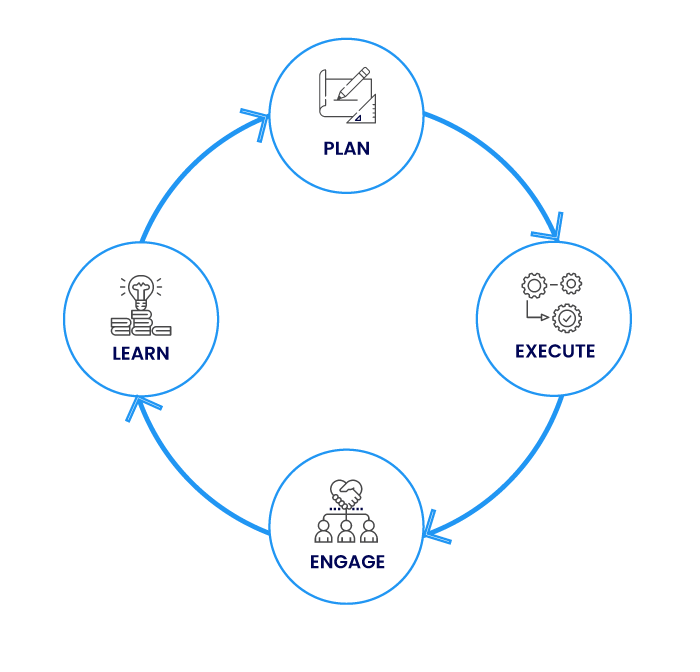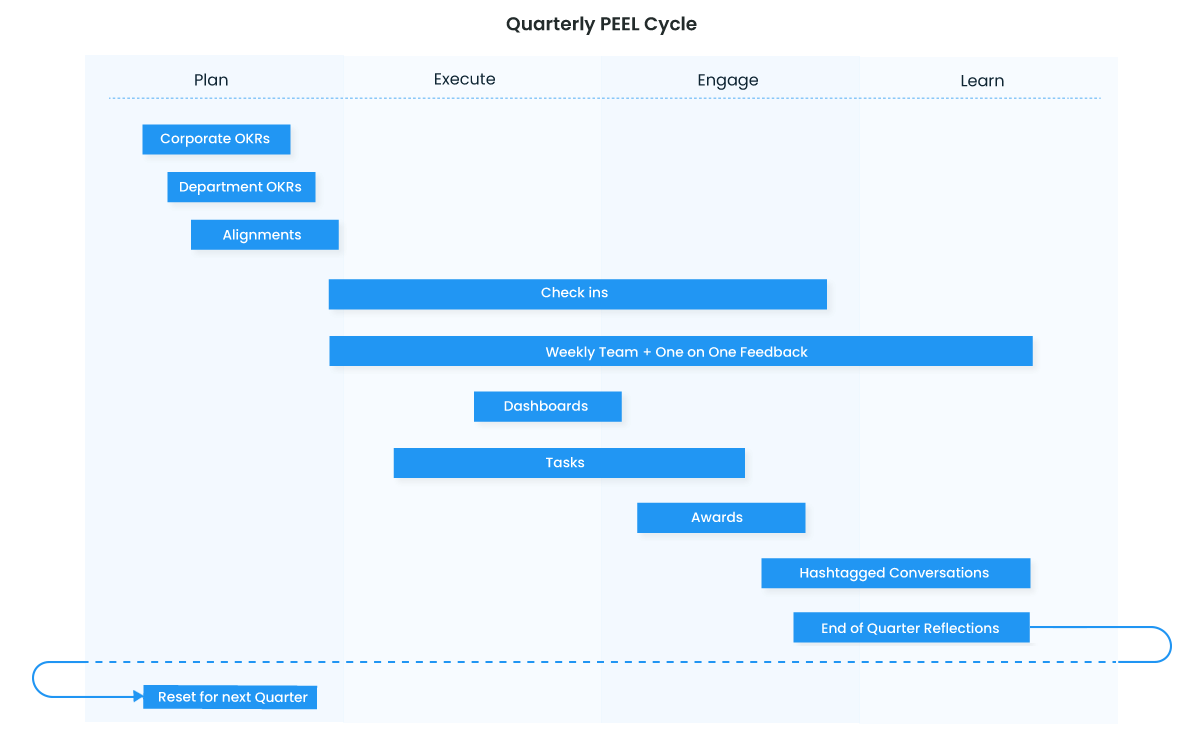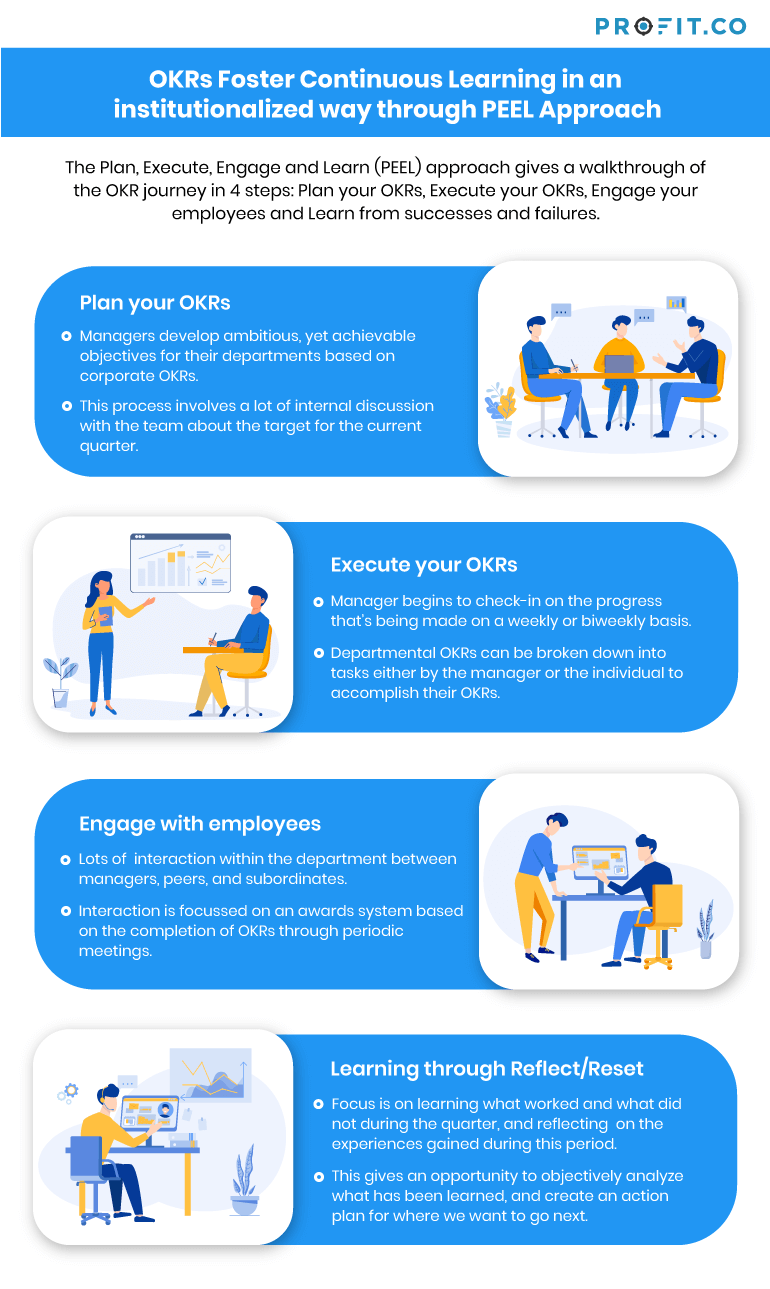While committing to the OKR methodology is a great first step to achieving your goals, it isn’t a magic quick-fix for businesses. The OKR framework is a way of executing strategy, and there are many things that need to be done right in order for your entire OKR program to be successful. Software is an important piece of the puzzle. So, Profit.co’s OKR software has been developed to help businesses move through the OKR cycle using the PEEL approach.
There are 4 clear parts in every successful OKR implementation, as shown in the picture below.

The PEEL approach walks you through each step of the OKR journey:
- Plan your OKRs
- Execute your OKRs
- Engage your employees
- Learn from your successes and failures in an institutionalized way

What are OKRs? OKR is not a single activity, but an activity system. The best way to think of your journey with OKRs is to imagine that you are riding a vehicle that runs on 4 wheels. All these 4 wheels need to be operated in a coordinated manner to ensure you get the best results from your OKR program. Plan your OKRs for free now!
OKR Planning
The first step, OKR planning, is extremely important. Within this stage, you need to determine what objectives are challenging yet achievable for you or your company. Whether that means refining past OKRs or creating new ones from scratch, this is the moment to determine corporate and departmental objectives.
This process involves a lot of discussion about the target. Where is your company today and where do you want it to be at the end of the quarter? What about at the end of the year? After, those involved will also determine the alignment of OKRs; from corporate to departments to teams to individuals, OKRs can all be linked together. As an individual, you can determine which organizational OKRs your individual OKRs link to and align them from the bottom up. It’s important to note that some of your department’s OKRs may be dependent on the completion of your individual OKRs or another employee’s. In this stage, those dependencies should be determined. Who needs to be involved in order to achieve this result? What actions need to be taken to make it happen?
Execution in the OKR Framework
Once all of the OKR planning is complete, the execution phase is where the work begins. Once OKRs have been set and determined, you can begin to check in on the progress that’s being made. You can decide how often these check-ins happen, whether they’re every other day or once a week–it’s up to you to determine if you’ve made enough progress in between each check-in period. There is also a comments section where you can share your thoughts and elaborate on your progress with your management or team.
For a more in-depth discussion, you also have the opportunity to organize weekly one-on-one or team feedback sessions. In Profit, we use PPP (progress, plans, and problems) methodology to frame these sessions, but you could also use your own method to conduct these reviews.
As you continue to focus on your own objectives and results, there is a dashboard feature in the program to help you keep track of what is going on throughout the entire corporation. Using this tool, you can see how each department is performing and how their performance contributes to the overall performance of the organization. This information can provide you with insight into how your OKRs contribute to the bigger picture.
To break down your OKRs, Profit allows you to create individual tasks that help you make progress and execute your key results. Your manager has the ability to assign tasks to you or you have the opportunity to create them for yourself.
Engaging with the OKR methodology
The third part of the cycle focuses on engaging employees. Profit allows you to interact with your managers, peers, and subordinates through an awards system that is based on the completion of OKRs. See how Profit.co can help teams engage with their top goals– schedule a free demo today!
Learning from your OKR goals
The final phase centers on learning. In this section, you are able to reflect on your OKR goals and experiences during this period. This gives you the opportunity to consider what you have learned already and where you want to go next. Even if you haven’t made progress with your OKR goals by the end of your target date, you’ve probably learned a lot over that period of time–like what doesn’t work in helping you achieve your results. Knowing what doesn’t work will ultimately help you and your peers in figuring out what might happen and you can use Profit to make note of these past attempts to help yourself in the future. In the performance section, you can also access your OKR reviews based on the completion of your OKRs in the current term. During this reflection time, it’s good to think about what worked well and what didn’t, what supports were needed, etc. Profit.co’s OKR tool supports continuous learning through well thought-through features.
After the learning phase, the cycle begins again with going back to plan your OKRs for your next period. This might mean creating entirely new OKRs, adding additional ones, or adjusting your previous objectives. The process of creating and executing OKRs and mastering the OKR framework isn’t finite. Instead, it’s a cycle that requires engagement and practice in order to truly learn from your experiences.
Setting your OKRs on a quarterly basis gives you a lot of advantages when it comes to continuous improvement. Teams that use the OKR framework have the opportunity to take what they have learned from one quarter– recording what worked, identifying what didn’t serve them– and use that knowledge to write stronger OKRs and execute their strategy better in the next quarter. Read more on the top 4 techniques for OKR Quarterly progress review and learn to close OKR cycle better.
The process of reflecting on your past quarter and putting those learnings into action is an extremely important pillar of any OKR program.

